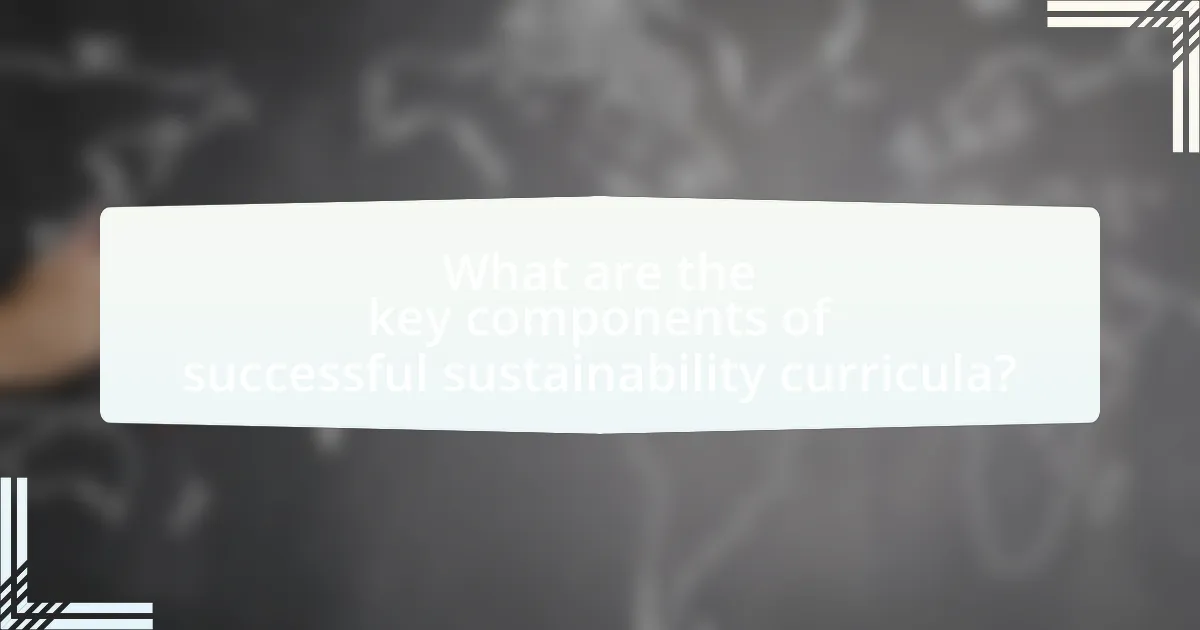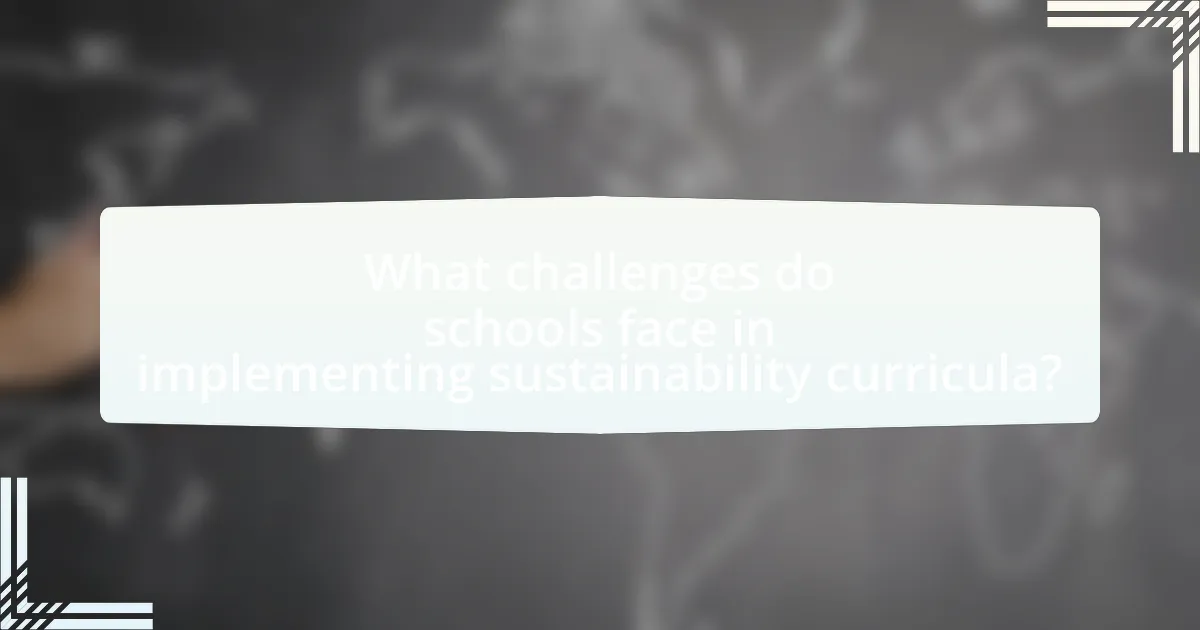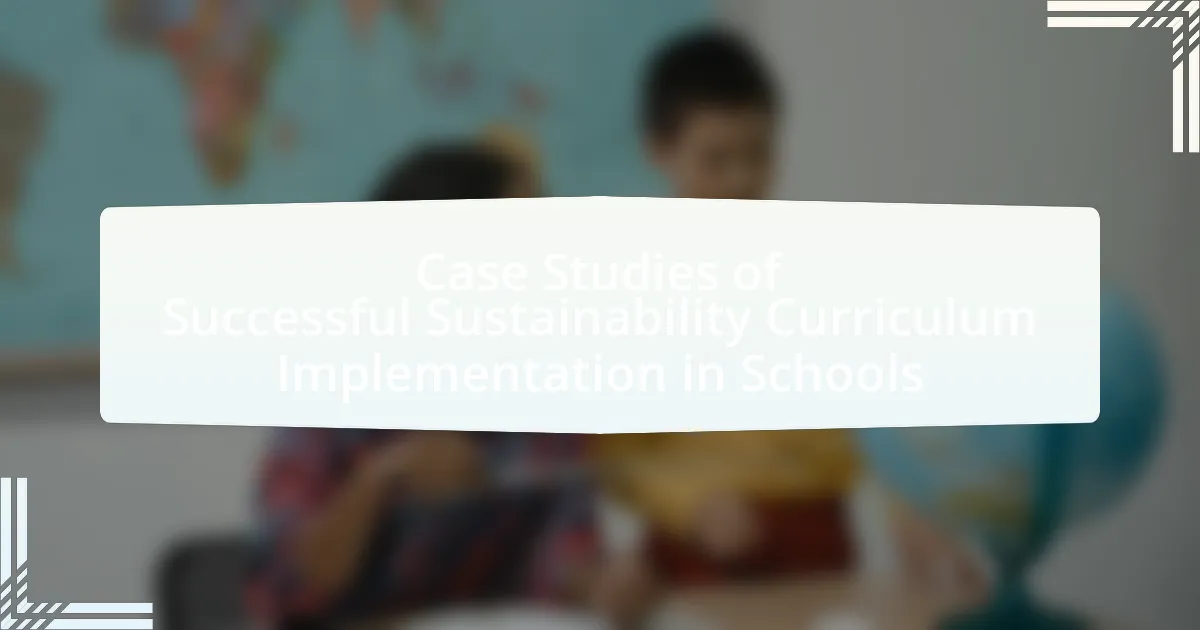The article focuses on case studies of successful sustainability curriculum implementation in schools, highlighting initiatives such as the Green Schools Initiative in California and the Eco-Schools program operating in over 60 countries. It examines effective sustainability practices demonstrated through integrated curriculum approaches, project-based learning, and community engagement, which lead to improved student performance and environmental awareness. The article also discusses the long-term benefits of sustainability education, including enhanced critical thinking, community involvement, and the development of eco-friendly behaviors among students, while addressing challenges schools face in implementing these curricula and strategies to overcome them.

What are Case Studies of Successful Sustainability Curriculum Implementation in Schools?
Case studies of successful sustainability curriculum implementation in schools include the Green Schools Initiative in California, which integrates environmental education into the core curriculum, resulting in increased student engagement and awareness of sustainability issues. Another example is the Eco-Schools program, which operates in over 60 countries and encourages schools to adopt sustainable practices, leading to measurable reductions in waste and energy consumption. Research conducted by the National Wildlife Federation shows that schools participating in these programs report improved student performance and a stronger sense of community responsibility.
How do these case studies demonstrate effective sustainability practices?
These case studies demonstrate effective sustainability practices by showcasing integrated curriculum approaches that engage students in real-world environmental challenges. For instance, one case study highlights a school that implemented a project-based learning model where students designed and executed a school garden, resulting in a 30% reduction in food waste and increased awareness of local food systems. Another case study illustrates a partnership with local environmental organizations, allowing students to participate in community clean-up events, which not only improved local ecosystems but also fostered a sense of civic responsibility among students. These examples provide concrete evidence of how hands-on, community-oriented projects can lead to measurable sustainability outcomes in educational settings.
What specific outcomes have been observed in schools implementing these curricula?
Schools implementing sustainability curricula have observed improved student engagement and academic performance. For instance, a study by the National Wildlife Federation found that schools integrating environmental education reported a 20% increase in student motivation and a 15% improvement in standardized test scores. Additionally, these schools often experience enhanced community involvement, with 70% of educators noting increased participation in local sustainability initiatives. This evidence demonstrates that sustainability curricula not only enrich educational outcomes but also foster a sense of responsibility and connection to the community among students.
How do these outcomes compare to traditional educational approaches?
Outcomes from successful sustainability curriculum implementation in schools often demonstrate greater student engagement and real-world application compared to traditional educational approaches. Traditional methods typically emphasize rote memorization and standardized testing, which can lead to passive learning. In contrast, sustainability-focused curricula encourage critical thinking, problem-solving, and collaboration, as evidenced by studies showing that students involved in project-based learning related to sustainability exhibit higher retention rates and a deeper understanding of complex systems. For instance, research conducted by the National Environmental Education Foundation found that students participating in environmental education programs scored significantly higher on standardized tests than their peers in traditional settings, highlighting the effectiveness of experiential learning in fostering both academic success and environmental stewardship.
Why is sustainability education important in schools?
Sustainability education is important in schools because it equips students with the knowledge and skills necessary to address environmental challenges. By integrating sustainability into the curriculum, schools foster critical thinking and problem-solving abilities, enabling students to understand the impact of their actions on the planet. Research indicates that students exposed to sustainability education are more likely to engage in environmentally responsible behaviors, as evidenced by a study published in the Journal of Environmental Education Research, which found that such education significantly increases students’ ecological literacy and commitment to sustainable practices.
What are the long-term benefits of sustainability education for students?
Sustainability education provides long-term benefits for students by fostering critical thinking, environmental stewardship, and social responsibility. Students who engage in sustainability education develop a deeper understanding of ecological systems and the impact of human activities on the environment, which enhances their ability to make informed decisions. Research indicates that students exposed to sustainability concepts are more likely to adopt eco-friendly behaviors and advocate for sustainable practices in their communities. For instance, a study published in the Journal of Environmental Education found that students who participated in sustainability programs showed a 30% increase in pro-environmental behaviors over five years. This education not only prepares students for future careers in green industries but also cultivates a generation that prioritizes sustainability in personal and professional contexts.
How does sustainability education impact community engagement?
Sustainability education significantly enhances community engagement by fostering awareness and encouraging active participation in local environmental initiatives. This educational approach equips individuals with knowledge about ecological issues, leading to increased community involvement in sustainability practices such as recycling programs, conservation efforts, and local clean-up events. Research indicates that schools implementing sustainability curricula, such as the Green Schools initiative, have seen a measurable increase in student-led community projects, demonstrating a direct correlation between education and community action. For instance, a study by the National Wildlife Federation found that schools with sustainability programs reported a 30% increase in student participation in community service related to environmental stewardship.

What are the key components of successful sustainability curricula?
The key components of successful sustainability curricula include interdisciplinary integration, experiential learning, community engagement, and critical thinking. Interdisciplinary integration allows students to connect sustainability concepts across subjects such as science, social studies, and economics, fostering a holistic understanding. Experiential learning, through hands-on projects and real-world applications, enhances student engagement and retention of knowledge. Community engagement involves collaboration with local organizations and stakeholders, providing students with practical insights and fostering a sense of responsibility. Critical thinking encourages students to analyze complex sustainability issues and develop innovative solutions. Research indicates that curricula incorporating these components lead to improved student outcomes and a deeper commitment to sustainability practices.
How do schools integrate sustainability into their existing curricula?
Schools integrate sustainability into their existing curricula by incorporating environmental education across various subjects and promoting hands-on projects that address local sustainability issues. For instance, science classes may include lessons on ecosystems and climate change, while social studies can explore the impact of human activities on the environment. Additionally, schools often implement school-wide initiatives, such as recycling programs and energy conservation efforts, which serve as practical applications of sustainability concepts taught in the classroom. Research indicates that schools that adopt a multidisciplinary approach to sustainability education not only enhance student engagement but also foster a deeper understanding of environmental stewardship, as evidenced by programs like the Eco-Schools initiative, which has successfully guided over 60,000 schools worldwide in integrating sustainability into their curricula.
What subjects are most commonly associated with sustainability education?
The subjects most commonly associated with sustainability education include environmental science, ecology, social studies, economics, and geography. Environmental science provides foundational knowledge about ecosystems and human impact, while ecology focuses on the relationships between organisms and their environment. Social studies examine the societal implications of sustainability, including policy and community engagement. Economics addresses the financial aspects of sustainable practices, and geography explores spatial relationships and resource distribution. These subjects collectively contribute to a comprehensive understanding of sustainability, as evidenced by various educational programs that integrate these disciplines to foster critical thinking and problem-solving skills related to environmental challenges.
How do interdisciplinary approaches enhance sustainability learning?
Interdisciplinary approaches enhance sustainability learning by integrating diverse perspectives and knowledge from various fields, which fosters a more comprehensive understanding of complex sustainability issues. For instance, combining insights from environmental science, economics, and social studies allows students to grasp the interconnectedness of ecological, economic, and social factors in sustainability. Research indicates that such integration leads to improved critical thinking and problem-solving skills, as students learn to analyze issues from multiple angles. A study by the National Academies of Sciences, Engineering, and Medicine highlights that interdisciplinary education promotes deeper engagement and retention of knowledge, ultimately preparing students to tackle real-world sustainability challenges effectively.
What teaching methods are most effective for sustainability education?
Experiential learning methods, such as project-based learning and outdoor education, are most effective for sustainability education. These methods engage students in real-world problem-solving and foster a deeper understanding of environmental issues. For instance, a study by the National Environmental Education Foundation found that students participating in project-based learning showed a 30% increase in their understanding of sustainability concepts compared to traditional teaching methods. Additionally, outdoor education programs have been shown to enhance students’ connection to nature, leading to more sustainable behaviors.
How do hands-on projects contribute to student understanding of sustainability?
Hands-on projects significantly enhance student understanding of sustainability by providing practical experiences that connect theoretical concepts to real-world applications. Engaging in activities such as community gardening, recycling initiatives, or renewable energy projects allows students to observe the impact of their actions on the environment directly. Research indicates that experiential learning increases retention and comprehension; for instance, a study published in the Journal of Environmental Education found that students participating in hands-on sustainability projects demonstrated a 30% increase in knowledge retention compared to traditional learning methods. This active involvement fosters critical thinking and problem-solving skills, essential for addressing sustainability challenges.
What role does outdoor learning play in sustainability education?
Outdoor learning plays a crucial role in sustainability education by providing experiential opportunities that enhance students’ understanding of environmental systems and their interconnectedness. Engaging with nature allows learners to observe ecological processes firsthand, fostering a deeper appreciation for biodiversity and the importance of conservation. Research indicates that outdoor learning experiences can significantly improve students’ environmental attitudes and behaviors, as demonstrated in studies such as the “Effects of Outdoor Education on Students’ Environmental Attitudes” published in the Journal of Environmental Education Research, which found that students who participated in outdoor education programs exhibited more pro-environmental behaviors compared to those who did not. This hands-on approach not only reinforces theoretical knowledge but also empowers students to take action towards sustainability in their communities.

What challenges do schools face in implementing sustainability curricula?
Schools face several challenges in implementing sustainability curricula, including limited funding, lack of teacher training, and insufficient resources. Limited funding restricts the ability to develop and maintain comprehensive programs, as schools often prioritize basic educational needs over sustainability initiatives. Additionally, many educators lack the necessary training to effectively teach sustainability concepts, which can lead to inconsistent implementation across classrooms. Insufficient resources, such as access to materials and technology, further complicate the integration of sustainability into existing curricula. These challenges hinder the effective adoption of sustainability education, as evidenced by studies showing that schools with dedicated funding and training programs report higher success rates in curriculum implementation.
How can schools overcome resistance to change in curriculum design?
Schools can overcome resistance to change in curriculum design by actively involving stakeholders in the decision-making process. Engaging teachers, parents, and students in discussions about the benefits and necessity of curriculum changes fosters a sense of ownership and reduces apprehension. Research indicates that when stakeholders are included, the likelihood of successful implementation increases significantly; for example, a study by Fullan (2007) highlights that collaborative approaches in educational reform lead to higher acceptance rates among educators. Additionally, providing professional development and resources equips teachers with the skills and confidence needed to adapt to new curricula, further mitigating resistance.
What strategies can be employed to gain stakeholder support?
To gain stakeholder support for sustainability curriculum implementation in schools, strategies such as engaging stakeholders through regular communication, demonstrating the benefits of the curriculum, and involving them in the decision-making process can be employed. Engaging stakeholders through consistent updates and feedback sessions fosters trust and transparency, which are crucial for building support. Demonstrating the benefits, such as improved student engagement and environmental awareness, can be backed by studies showing that schools with sustainability programs report higher student satisfaction and academic performance. Involving stakeholders, including teachers, parents, and community members, in the decision-making process ensures their voices are heard, leading to a sense of ownership and commitment to the curriculum.
How can funding and resources be secured for sustainability initiatives?
Funding and resources for sustainability initiatives can be secured through a combination of grants, partnerships, and community engagement. Schools can apply for government and private grants specifically aimed at environmental education and sustainability projects, such as the Environmental Protection Agency’s Environmental Education Grants, which provide funding for innovative educational programs. Additionally, forming partnerships with local businesses and non-profits can lead to resource sharing and financial support, as these organizations often seek to enhance their community involvement and corporate social responsibility. Engaging the community through fundraising events and awareness campaigns can also generate local support and financial contributions, fostering a sense of ownership and commitment to sustainability initiatives.
What are the best practices for evaluating sustainability curriculum effectiveness?
The best practices for evaluating sustainability curriculum effectiveness include establishing clear learning objectives, utilizing diverse assessment methods, and gathering feedback from multiple stakeholders. Clear learning objectives ensure that the curriculum aligns with desired outcomes, such as knowledge of sustainability principles and behavioral changes. Diverse assessment methods, including formative assessments, summative assessments, and project-based evaluations, provide a comprehensive view of student understanding and engagement. Gathering feedback from students, teachers, and community members enhances the evaluation process by incorporating various perspectives, which can lead to continuous improvement of the curriculum. Research indicates that programs with well-defined objectives and multi-faceted assessment strategies demonstrate higher effectiveness in achieving sustainability education goals.
What metrics can be used to assess student engagement and learning outcomes?
Metrics used to assess student engagement and learning outcomes include attendance rates, participation in class discussions, assignment completion rates, and standardized test scores. Attendance rates indicate how often students are present, reflecting their interest and commitment to the curriculum. Participation in class discussions shows active engagement and understanding of the material. Assignment completion rates provide insight into students’ ability to apply what they have learned, while standardized test scores measure academic achievement and learning outcomes. Research has shown that higher attendance and participation correlate with improved academic performance, reinforcing the validity of these metrics in evaluating student engagement and learning outcomes.
How can feedback from students and teachers inform curriculum improvements?
Feedback from students and teachers can significantly inform curriculum improvements by identifying gaps in understanding and areas for enhancement. For instance, student feedback can reveal which topics are engaging or challenging, allowing educators to adjust lesson plans accordingly. Teacher feedback can provide insights into instructional effectiveness and resource adequacy, guiding curriculum developers to refine content and teaching strategies. Research indicates that schools implementing regular feedback mechanisms, such as surveys and focus groups, have seen improved student performance and satisfaction, demonstrating the direct impact of incorporating stakeholder input into curriculum design.
What practical tips can schools follow to successfully implement sustainability curricula?
Schools can successfully implement sustainability curricula by integrating hands-on projects, fostering community partnerships, and utilizing interdisciplinary approaches. Hands-on projects, such as school gardens or recycling programs, engage students actively and provide practical experience in sustainability. Community partnerships with local organizations can enhance resources and expertise, allowing schools to implement real-world sustainability initiatives. Interdisciplinary approaches, which combine subjects like science, social studies, and art, help students understand the multifaceted nature of sustainability. Research indicates that schools employing these strategies see improved student engagement and understanding of sustainability concepts, as evidenced by case studies from institutions like the Green Schools Initiative, which reported increased student participation and awareness in sustainability efforts.

Leave a Reply